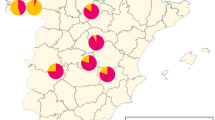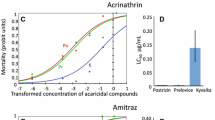Abstract
The purpose of this study was to estimate the acaricide susceptibility of Varroa destructor populations from Uruguay, which had never been exposed to synthetic acaricides. It was also to determine whether acaricide resistance to coumaphos occurred in apiaries in which acaricide rotation had been applied. Bioassays with acaricides against mite populations that had never been exposed to synthetic acaricides were performed, also against mite populations in which control failures with coumaphos had been reported. Additionally, coumaphos’ effectiveness in honeybee colonies was experimentally tested. The lethal concentration that kills 50% of the exposed animals (LC50) for susceptible mite populations amounted to 0.15 μg/Petri dish for coumaphos and to less than 0.3 μg/Petri dish for the other acaricides. Coumaphos LC50 was above 40 μg/Petri dish for resistant mites. The effectiveness of coumaphos in honeybee colonies parasitized by V. destructor ranged from 17.6% to 93.9%. LC50 for mite populations susceptible to the most commonly applied miticides was determined, and the first case of coumaphos resistance recorded in Uruguay was established.

Similar content being viewed by others
References
Abbott W (1925) A method of computing the effectiveness of an insecticide. J Econ Entomol 18:265–267
Anderson Dl, Trueman J (2000) Varroa jacobsoni is more than one species. Exp App Acarol 24:165–189
APHA (American Public Health Association–American Water Works Association and Water Pollution Control Federation) (1992) Standard methods for the examination of water and wastewaters, 18th ed. American Public Health Association, Washington D.C
Bogdanov S (2006) Contaminants of bee products. Apidologie 37:1–18
Coles G, Kinoti G (1997) Defining resistance in Schistosoma. Parasitol Today 13:4
Colin M, Vandame R, Jourdan P, Pasquale S (1997) Fluvalinate resistance of Varroa jacobsoni Oudemans (Acari: Varroidae) in Mediterranean apiaries of France. Apidologie 28:375–384
De Jong D (2005) Workshop sobre control de la Varroosis en Climas Subtropicales. 27 y 28 de junio, Salta Argentina.
Eguaras M, Ruffinengo S (2006) Estrategias para el control de Varroa. Ed. Martin, Mar del Plata
Elzen P, Westervelt D (2002) Detection of coumaphos resistance in Varroa destructor in Florida. Am Bee J 142:291–292
Elzen P, Eischen F, Baxter J, Pettis J, Elzen G, Wilson W (1998) Fluvalinate resistance in Varroa jacobsoni from several geographic locations. Am Bee J 138(9):674–676
Elzen P, Baxter J, Spivak M, Wilson W (1999) Amitraz resistance in Varroa: new discovery in North America. Am Bee J 139(5):362
Elzen P, Baxter J, Spivak M, Wilson W (2000) Control of Varroa jacobsoni Oud. resistant to fluvalinate and amitraz using coumaphos. Apidologie 31:437–441
Floris I, Cabras P, Garau V, Minelli E, Satta A, Troullier J (2001) Persistence and effectiveness of pyrethroids in plastics strips against Varroa jacobsoni (Acari: Varroidae) and mite resistance in a Mediterranean area. J Econ Entomol 94(4):806–810
Fries I, Wallner K, Rosenkranz P (1998) Effects on Varroa jacobsoni from acaricides in beeswax. J Apicult Res 37(2):85–90
Greatti M, Milani N, Nazzi F (1992) Reinfestation of an acaricide-treated apiary by Varroa jacobsoni Oud. Exp App Acarol 16(4):279–286
Herbert W, Wittherell P, Shimanuki H (1988) Control of Varroa jacobsoni in queen cages and small laboratory cages using amitraz, fluvalinate, and apitol. Am Bee J 128(4):289–292
Lindberg C, Melathopoulus A, Winston M (2000) Laboratory evaluation of miticides to control Varroa jacobsoni, a honeybee parasite. J Apicult Res 93:189–198
Lodesani M, Colombo M, Spreafico M (1995) Ineffectiveness of Apistan treatment against the mite Varroa jacobsoni Oud. in several districts of Lombardy (Italy). Apidologie 26:67–72
Macedo P, Ellis M, Siegfried B (2002) Detection and quantification of fluvalinate resistance in Varroa mites in Nebraska. Am Bee J 178(2):523–526
Maggi M, Ruffinengo S, Gende L, Eguaras N, Sardella N (2008) LC50 baseline levels of amitraz, coumaphos, fluvalinate and flumethrin in populations of Varroa destructor from Buenos Aires Province, Argentina. J Apicult Res 47(4):292–295
Maggi M, Ruffinengo S, Damiani N, Sardella N, Eguaras M (2009) A first detection of Varroa destructor resistance to coumaphos in Argentina. Exp App Acarol 47(4):317–320
Maggi M, Damiani N, Ruffinengo S, Principal J, de Jong D, Eguaras M (2010) Brood cell size of Apis mellifera modifies the reproductive behavior of Varroa destructor. Exp App Acarol 50(3):269–279
Mathieu L, Faucon J (2000) Changes in the response time for Varroa jacobsoni exposed to amitraz. J Apicult Res 39(3–4):155–158
Milani N (1995) The resistance of Varroa jacobsoni Oud to pyrethroids: a laboratory assay. Apidologie 26:415–429
OECD (1998) Honeybees, acute oral toxicity test. OECD guidelines for the testing of chemicals, guideline 213
Onstad D (2008) Insecticide resistance management: biology, economics and prediction. Ed Academic Press, San Diego
Rodriguez-Dehaibes SR, Otero-Colina G, Sedas VP, Jimenez JA (2005) Resistance to amitraz and flumethrin in Varroa destructor populations from Veracruz, Mexico. J Apicult Res 44:124–125
Sammataro D, Untalan P, Guerro F, Finley J (2005) The resistance of Varroa mites (Acari: Varroidae) to acaricides and the presence of esterase. Int J Acarol 31(1):67–74
Schaub L, Sardy S, Capkun G (2002) Natural variation in baseline data: when do we call a new sample “resistant”? Pest Manag Sci 58:959–963
Tabashnik BE (1989) Managing resistance with multiple pesticide tactics: theory, evidence and recommendations. J Econ Entomol 82:1263–1269
Thompson H, Brown M, Ball R, Bew M (2002) First report of Varroa destructor resistance to pyrethroids in the UK. Apidologie 33:357–366
United States Environmental Protection Agency (1986) Hazard evaluation division. Standard evaluation procedure. Ecological risk assessment EPA 540/9-85-001, p 96
Wallner K (1999) Varroacides and their residues in bee products. Apidologie 30:235–248
Watkins M (1997) Resistance and its relevance to beekeeping. Bee World 78:15–22
Acknowledgments
The authors would like to thank the UNMDP, CONICET, and CREO (Oportunidades para Conservación, Investigación y Educación). This research was supported by a grant of ANPCyT, Picto 443 to M. E. and by a grant of Creo to M. M.
Author information
Authors and Affiliations
Corresponding author
Rights and permissions
About this article
Cite this article
Maggi, M.D., Ruffinengo, S.R., Mendoza, Y. et al. Susceptibility of Varroa destructor (Acari: Varroidae) to synthetic acaricides in Uruguay: Varroa mites’ potential to develop acaricide resistance. Parasitol Res 108, 815–821 (2011). https://doi.org/10.1007/s00436-010-2122-5
Received:
Accepted:
Published:
Issue Date:
DOI: https://doi.org/10.1007/s00436-010-2122-5




